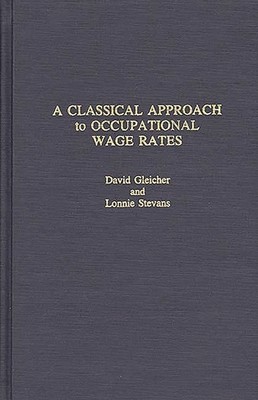
- We will send in 10–14 business days.
- Author: David Gleicher
- Publisher: Praeger
- ISBN-10: 0275932230
- ISBN-13: 9780275932237
- Format: 14.5 x 22.3 x 1.7 cm, hardcover
- Language: English
- SAVE -10% with code: EXTRA
Reviews
Description
David Gleicher and Lonnie Stevans present a theory of occupational wage rates that is a classical alternative to human capital theory. They introduce the net employment reserve, a novel explanatory variable that measures the bargaining power of employees in an occupation. An econometric model which includes net reserves is designed and tested. Results suggest standard empirical tests of human capital theory are misspecified. Other topics include: the origin of the firm, screening hypothesis, wage-efficiency, internal labor markets, and labor-market segmentation. This work offers insight into the theoretical and econometric modeling of labor specialization, as well as wage-rate differentials among occupations. It addresses researchers and graduate students in labor economics, classical price theory, and general political economy.
Gleicher and Stevans design an empirical study of the determination of occupational wage-rates, testing the net reserve against other hypothesized variables. Their first two chapters model relative wage rates within a broad classical conception: a simple model of relative prices is extended by incorporating relative wage rates according to occupation and training services. (The authors discuss the implications of these extensions with regard to the labor theory of value.) A testable hypothesis is put forth in Chapters 3 and 4. The fifth and final chapter presents econometric results.
EXTRA 10 % discount with code: EXTRA
The promotion ends in 20d.23:51:19
The discount code is valid when purchasing from 10 €. Discounts do not stack.
- Author: David Gleicher
- Publisher: Praeger
- ISBN-10: 0275932230
- ISBN-13: 9780275932237
- Format: 14.5 x 22.3 x 1.7 cm, hardcover
- Language: English English
David Gleicher and Lonnie Stevans present a theory of occupational wage rates that is a classical alternative to human capital theory. They introduce the net employment reserve, a novel explanatory variable that measures the bargaining power of employees in an occupation. An econometric model which includes net reserves is designed and tested. Results suggest standard empirical tests of human capital theory are misspecified. Other topics include: the origin of the firm, screening hypothesis, wage-efficiency, internal labor markets, and labor-market segmentation. This work offers insight into the theoretical and econometric modeling of labor specialization, as well as wage-rate differentials among occupations. It addresses researchers and graduate students in labor economics, classical price theory, and general political economy.
Gleicher and Stevans design an empirical study of the determination of occupational wage-rates, testing the net reserve against other hypothesized variables. Their first two chapters model relative wage rates within a broad classical conception: a simple model of relative prices is extended by incorporating relative wage rates according to occupation and training services. (The authors discuss the implications of these extensions with regard to the labor theory of value.) A testable hypothesis is put forth in Chapters 3 and 4. The fifth and final chapter presents econometric results.


Reviews